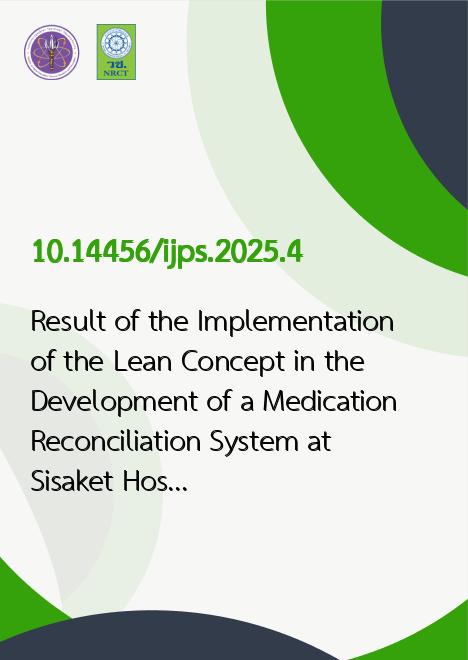
|
Result of the Implementation of the Lean Concept in the Development of a Medication Reconciliation System at Sisaket Hospital |
|---|---|
| รหัสดีโอไอ | |
| Creator | Paweesuda Samsri |
| Title | Result of the Implementation of the Lean Concept in the Development of a Medication Reconciliation System at Sisaket Hospital |
| Contributor | Pichaya Vorachak, Akaraphong Thaweephat |
| Publisher | Faculty of Pharmaceutical Sciences KKU MSU UBU |
| Publication Year | 2568 |
| Journal Title | Isan Journal of Pharmaceutical Sciences |
| Journal Vol. | 21 |
| Journal No. | 1 |
| Page no. | 51-63 |
| Keyword | medication reconciliation process, LEAN concept, information technology |
| URL Website | https://tci-thaijo.org/index.php/IJPS |
| Website title | Isan Journal of Pharmaceutical Sciences, IJPS |
| ISSN | 19050852 |
| Abstract | Medication reconciliation is an essential component of drug management systems that ensures the continuous administration of medications and minimizes medication errors. However, an analysis of the current operational procedures at Sisaket Hospital has identified redundant steps, time inefficiencies, and excessive waiting times, which affect the efficiency and quality of service. The LEAN conceptfocused on improving efficiency and reducing waste in work processeshas been applied to develop a new medication reconciliation system to address these issues. This system aims to eliminate unnecessary steps, speed up service delivery, and enhance the quality of patient care at Sisaket Hospital. Objective: To develop a system and reduce unnecessary steps in the medication reconciliation process. Method: This action research consisted of four phases: 1) analyzing the current situation and identifying problems, 2) developing the system, 3) implementing the process, The pilot study was conducted in a medical ward, and 4) Evaluation of Implementation Outcomes Data collection was conducted before the system development from October 1, 2022, to September 30, 2023, and after the system development from October 1, 2023, to September 30, 2024. Descriptive statistics were used for data analysis. Result: After developing the medication reconciliation process, we reduced the number of steps from six to four, resulting in a 32% decrease in processing time (from 82 minutes to 56 minutes). The percentage of medication reconciliations completed within 24 hours rose from 73.55% (before development) to 90.56% (after development), exceeding our target of at least 80%. Additionally, 36.36% of physicians used the newly created Medication Reconciliation form as part of their orders. After developing the medication reconciliation with the PharMS program, the steps were reduced from five to two, and the processing time was reduced by 57% (from 63 seconds to 27 seconds). Pharmacists found more drug-related problems from medication reconciliation from 42 times (before development) to 120 times (after development). As a result, the medication error prevention and resolution rate improved from 71.43% to 90%. Conclusion: Integrating the PharMS program and the LEAN concept enhanced operational efficiency, streamlined pharmacists' medication reconciliation, and reduced medication errors, ultimately improving patient safety. |
